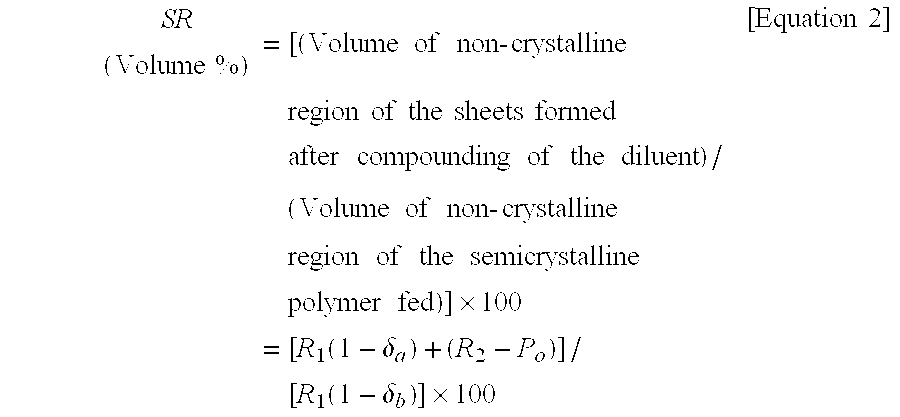Microporous film of semicrystalline polymers and method for preparing the same
- Summary
- Abstract
- Description
- Claims
- Application Information
AI Technical Summary
Benefits of technology
Problems solved by technology
Method used
Image
Examples
embodiment 1
Preferred Embodiment 1
[0061] High-density polyethylene having a weight average molecular weight of 3.0×105 g / mol was used for the semicrystalline polymer, and dibutylphthalate was used for the diluent. The weight ratio of the semicrystalline polymer and the diluent was 40 / 60, and the volume ratio was 42.4 / 57.6. This composition was subject to liquid-liquid phase separation, and the residence time in an extruder at a temperature lower than the temperature of phase separation was 100 seconds. The temperature of extrusion was 250° C., and the temperature of phase separation in the extruder was 180° C. The heat of fusion of high-density polyethylene used was 190 J / g, and the crystallinity was 64.4%. And the heat of fusion in the sheets extruded was 91 J / g making the crystallinity excluding the diluent 77.1%. It was seen that the crystallinity of polyethylene itself was increased as affected by the diluent. Stretching of the sheets was done by simultaneous stretching of 6 times each in t...
embodiment 2
Preferred Embodiment 2
[0062] As semicrystalline polymers, 90 weight % of high-density polyethylene having a weight average molecular weight of 4.0×105 g / mol and containing 0.5 weight % of butene-1 as a co-monomer, and 10 weight % of homopolypropylene having a weight average molecular weight of 4.5×105 g / mol were used. Dibutylphthalate was used for the diluent. The weight ratio of the semicrystalline polymers and the diluent was 35 / 65, and the volume ratio was 37.6 / 62.4. The heat of fusion of high-density polyethylene used was 155 J / g, and the crystallinity was 52.5%. and the heat of fusion in the sheets was 58.5 J / g, and the crystallinity excluding the diluent and polypropylene was 63.0%. The heat of fusion of homopolypropylene used was 85 J / g, and the crystallinity was 59%. And the heat of fusion in the sheets was 3.8 J / g, and the crystallinity excluding the diluent and polyethylene was 74.9%. Therefore, the average crystallinity of semicrystalline resins used was 53.1%, and the av...
PUM
| Property | Measurement | Unit |
|---|---|---|
| Fraction | aaaaa | aaaaa |
| Fraction | aaaaa | aaaaa |
| Fraction | aaaaa | aaaaa |
Abstract
Description
Claims
Application Information
 Login to View More
Login to View More - R&D
- Intellectual Property
- Life Sciences
- Materials
- Tech Scout
- Unparalleled Data Quality
- Higher Quality Content
- 60% Fewer Hallucinations
Browse by: Latest US Patents, China's latest patents, Technical Efficacy Thesaurus, Application Domain, Technology Topic, Popular Technical Reports.
© 2025 PatSnap. All rights reserved.Legal|Privacy policy|Modern Slavery Act Transparency Statement|Sitemap|About US| Contact US: help@patsnap.com

